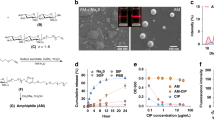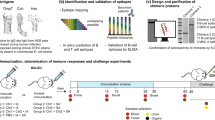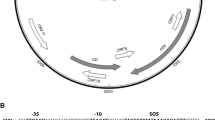Abstract
Gastrointestinal disease caused by Shiga toxin-producing bacteria (such as Escherichia coli O157:H7 and Shigella dysenteriae) is often complicated by life-threatening toxin-induced systemic sequelae, including hemolytic–uremic syndrome. Such infections can now be diagnosed very early in the course of the disease, but at present no effective therapeutic intervention is possible. Here, we constructed a recombinant bacterium that displayed a Shiga toxin receptor mimic on its surface, and it adsorbed and neutralized Shiga toxins with very high efficiency. Moreover, oral administration of the recombinant bacterium completely protected mice from challenge with an otherwise 100%-fatal dose of Shiga toxigenic E. coli. Thus, the bacterium shows great promise as a ‘probiotic’ treatment for Shiga toxigenic E. coli infections and dysentery.
This is a preview of subscription content, access via your institution
Access options
Subscribe to this journal
Receive 12 print issues and online access
$209.00 per year
only $17.42 per issue
Buy this article
- Purchase on Springer Link
- Instant access to full article PDF
Prices may be subject to local taxes which are calculated during checkout





Similar content being viewed by others
References
O'Brien, A.D. & Holmes, R.K. Shiga and shiga-like toxins. Microbiol. Rev. 51, 206–220 (1987).
Karmali, M.A. Infection by verocytotoxin-producing E. coli. Clin. Microbiol. Rev. 2, 15–38 ( 1989).
Nataro, J.P. & Kaper, J.B. Diarrheagenic Escherichia coli. Clin. Microbiol. Rev. 11, 142– 201 (1998).
Paton, J.C. & Paton, A.W. Pathogenesis and diagnosis of Shiga toxin-producing Escherichia coli infections. Clin. Microbiol. Rev. 11, 450–479 ( 1998).
Lingwood, C.A. Role of verotoxin receptors in pathogenesis. Trends Microbiol. 4, 147–153 ( 1996).
DeGrandis, S., Law, H., Brunton, J., Gyles, C. & Lingwood, C.A. Globotetraosyl ceramide is recognized by the pig edema disease toxin. J. Biol. Chem. 264, 12520 –12525 (1989).
Paton, A.W. et al. Molecular microbiological investigation of an outbreak of hemolytic uremic syndrome caused by dry fermented sausage contaminated with Shiga-like toxin-producing Escherichia coli. J. Clin. Microbiol. 34, 1622–1627 ( 1996).
Paton, A.W., Woodrow, M.C., Doyle, R.M., Lanser, J.A. & Paton, J.C. Molecular characterization of a Shiga-toxigenic Escherichia coli O113:H21 strain lacking eae responsible for a cluster of cases of hemolytic-uremic syndrome. J. Clin. Microbiol. 37, 3357–3361 (1999).
Wakarchuk, W.W. et al. Structure of an alpha-2,6-sialylated lipooligosaccharide from Neisseria meningitidis immunotype L1. Eur. J. Biochem. 254, 626–633 (1998).
Mandrell, R.E. & Apicella, M.A. Lipooligosaccharides (LOS) of mucosal pathogens: molecular mimicry and host modification of LOS . Immunobiology 187, 382– 402 (1993).
Risberg, A. et al. Structural analysis of the lipopolysaccharide oligosaccharide epitopes expressed by a capsule deficient strain of Haemophilus influenzae Rd. Eur. J. Biochem. 261, 171– 180 (1999).
Masoud, H., Moxon, E.R., Martin, A., Krajcarski, D. & Richards, J.C. Structure of the variable and conserved lipopolysaccharide oligosaccharide epitopes expressed by Haemophilus influenzae serotype b strain Eagan. Biochemistry 36, 2091– 2103 (1997).
Gotschlich, E.C. Genetic locus for the biosynthesis of the variable portion of Neisseria gonorrhoeae lipopolysaccharide. J. Exp. Med. 180 , 2181–2190 (1994).
Yang, Q.-L. & Gotschlich, E.C. Variation of gonococcal lipooligosaccharide structure is due to alterations in poly-G tracts in lgt genes encoding glycosyl transferases. J. Exp. Med. 183, 323–327 (1996).
Jennings, M.P., Hood, D.W., Peak, I.R., Virji, M. & Moxon, E.R. Molecular analysis of a locus for the biosynthesis and phase-variable expression of the lacto-N-neotetraose terminal lipopolysaccharide structure in Neisseria meningitidis. Mol. Microbiol. 18, 729–740 (1995).
Heinrichs, D.E., Yethon, J.A., Amor, P.A. & Whitfield, C. The assembly system for the outer core portion of R1- and R4-type lipopolysaccharides of Escherichia coli. J. Biol. Chem. 273, 29497–29505 (1998).
Lindgren, S.W., Melton, A.R. & O'Brien, A.D. Virulence of enterohemorrhagic Escherichia coli O91:H21 clinical isolates in an orally infected mouse model. Infect. Immun. 61, 3832–3842 (1993).
Armstrong, G.D., Fodor, E. & and Vanmaele, R. Investigation of Shiga-like toxin binding to chemically synthesized oligosaccharide sequences. J. Infect. Dis. 164, 1160–1167 (1991).
Takeda, T., Yoshino, K., Adachi, E., Sato, Y. & Yamagata, K. In vitro assessment of a chemically synthesized Shiga toxin receptor analog attached to chromosorb P (Synsorb Pk) as a specific absorbing agent of Shiga toxin 1 and 2. Microbiol. Immunol. 43, 331–337 (1999).
Rogers, J.E., Armstrong, G. & O'Brien, A.D. Abstract V149/VII, 114 (3rd International Symposium and Workshop on Shiga Toxin (Verotoxin)-producing Escherichia coli Infections, Baltimore, Maryland, June, 1997). (Lois Joy Galler Foundation for Hemolytic Uremic Syndrome, Melville, New York, 1997).
Armstrong, G.D. et al. A phase I study of chemically synthesized verotoxin (Shiga-like toxin) Pk-trisaccharide receptors attached to chromosorb for preventing hemolytic-uremic syndrome. J. Infect. Dis. 171, 1042– 1045 (1995).
Liljeqvist, S. & Stahl, S. Production of recombinant subunit vaccines: protein immunogens, live delivery systems and nucleic acid vaccines. J. Biotech. 73, 1– 33 (1999).
Clements, J.D., Hartzog, N.M. & Lyon, F.L. Adjuvant activity of Escherichia coli heat-labile enterotoxin and effect on the induction of oral tolerance in mice to unrelated protein antigens. Vaccine 6, 269– 277 (1988).
Moran, A.P., Prendergast, M.M. & Appelmelk, B.J. Molecular mimicry of host structures by bacterial lipopolysaccharides and its contribution to disease. FEMS Immunol. Med. Microbiol. 16, 105–115 (1996).
Maniatis, T., Fritsch, E.F. & Sambrook, J. in Molecular cloning: A Laboratory Manual p. 68 (Cold Spring Harbor Laboratory, Cold Spring Harbor, New York, 1982).
Darveau, R.P. & Hancock, R.E. Procedure for isolation of bacterial lipopolysaccharides from both smooth and rough Pseudomonas aeruginosa and Salmonella typhimurium strains. J. Bacteriol. 155, 831–838 (1983).
Morona, R., Brown, M.H., Yeadon, J., Heuzenroeder, M.W. & Manning, P.A. Effect of lipopolysaccharide core synthesis mutations on the production of Vibrio cholerae O-antigen in Escherichia coli K-12. FEMS Microbiol. Lett. 663, 279 –285 (1991).
Klauser, T., Pohlner, J. & Meyer, T.F. Extracellular transport of cholera toxin B subunit using Neisseria IgA protease beta-domain: conformation-dependent outer membrane translocation. EMBO J. 9, 1991– 1999 (1990).
Wadolkowski, E.A., Burris, J.A. & O'Brien, A.D. Mouse model for colonization and disease caused by enterohemorrhagic Escherichia coli O157:H7. Infect. Immun. 58, 2438–2445 ( 1990).
Wadolkowski, E.A., Sung, L.M., Burris, J.A., Samuel, J.A. & O'Brien, A.D. Acute renal tubular necrosis and death of mice orally infected with Escherichia coli strains that produce Shiga-like toxin type II. Infect. Immun. 58, 3959– 3965 (1990).
O'Brien, A.D., et al. Shiga-like toxin-converting phages from Escherichia coli strains that cause hemorrhagic colitis or infantile diarrhea. Science 226, 694–696 ( 1984).
Yanisch-Perron, C., Vieira, J. & Messing, J. Improved M13 phage cloning vectors and host strains: nucleotide sequences of the M13 mp18 and pUC19 vectors. Gene 33, 103–119 (1985).
Paton, A.W., Paton, J.C. & Manning, P.A. Polymerase chain reaction amplification, cloning and sequencing of variant Escherichia coli Shiga-like toxin type II operons . Microb. Pathog. 15, 77– 82 (1993).
Paton, A.W., Beutin, L. & Paton, J.C. Heterogeneity of the amino-acid sequences of Escherichia coli Shiga-like toxin type-I operons. Gene 153, 71–74 (1995).
Ito, H., Terai, A., Kurazono, H., Takeda, Y. & Nishibuchi, M. Cloning and nucleotide sequencing of Vero toxin 2 variant genes from E. coli O91:H21 isolated from a patient with HUS. Microb. Pathogen. 8, 47–60 (1990).
Jobling, M.G. & Holmes, R.K. Construction of vectors with the p15a replicon, kanamycin resistance, inducible lacZαand pUC18 or pUC19 multiple cloning sites. Nucleic Acids Res. 18, 5315–5316 (1990).
Vinogradov, E.V. et al. The structures of the carbohydrate backbones of the lipopolysaccharides from Escherichia coli rough mutants F470 (R1 core type) and F576 (R2 coretype). Eur. J. Biochem. 261, 629– 639 (1999).
Acknowledgements
The assistance of L. van den Bosch and E. Parker is acknowledged. This work was supported by grants from the National Health and Medical Research Council of Australia, and the Channel Seven Children's Research Foundation.
Author information
Authors and Affiliations
Corresponding author
Rights and permissions
About this article
Cite this article
Paton, A., Morona, R. & Paton, J. A new biological agent for treatment of Shiga toxigenic Escherichia coli infections and dysentery in humans. Nat Med 6, 265–270 (2000). https://doi.org/10.1038/73111
Received:
Accepted:
Issue Date:
DOI: https://doi.org/10.1038/73111
This article is cited by
-
Engineering the gut microbiome
Nature Reviews Bioengineering (2023)
-
Evaluation of the Role of Probiotics As a New Strategy to Eliminate Microbial Toxins: a Review
Probiotics and Antimicrobial Proteins (2022)
-
Development of bacteria as diagnostics and therapeutics by genetic engineering
Journal of Microbiology (2019)
-
Engineering bacteria for diagnostic and therapeutic applications
Nature Reviews Microbiology (2018)
-
Probiotic engineering: towards development of robust probiotic strains with enhanced functional properties and for targeted control of enteric pathogens
Gut Pathogens (2017)



